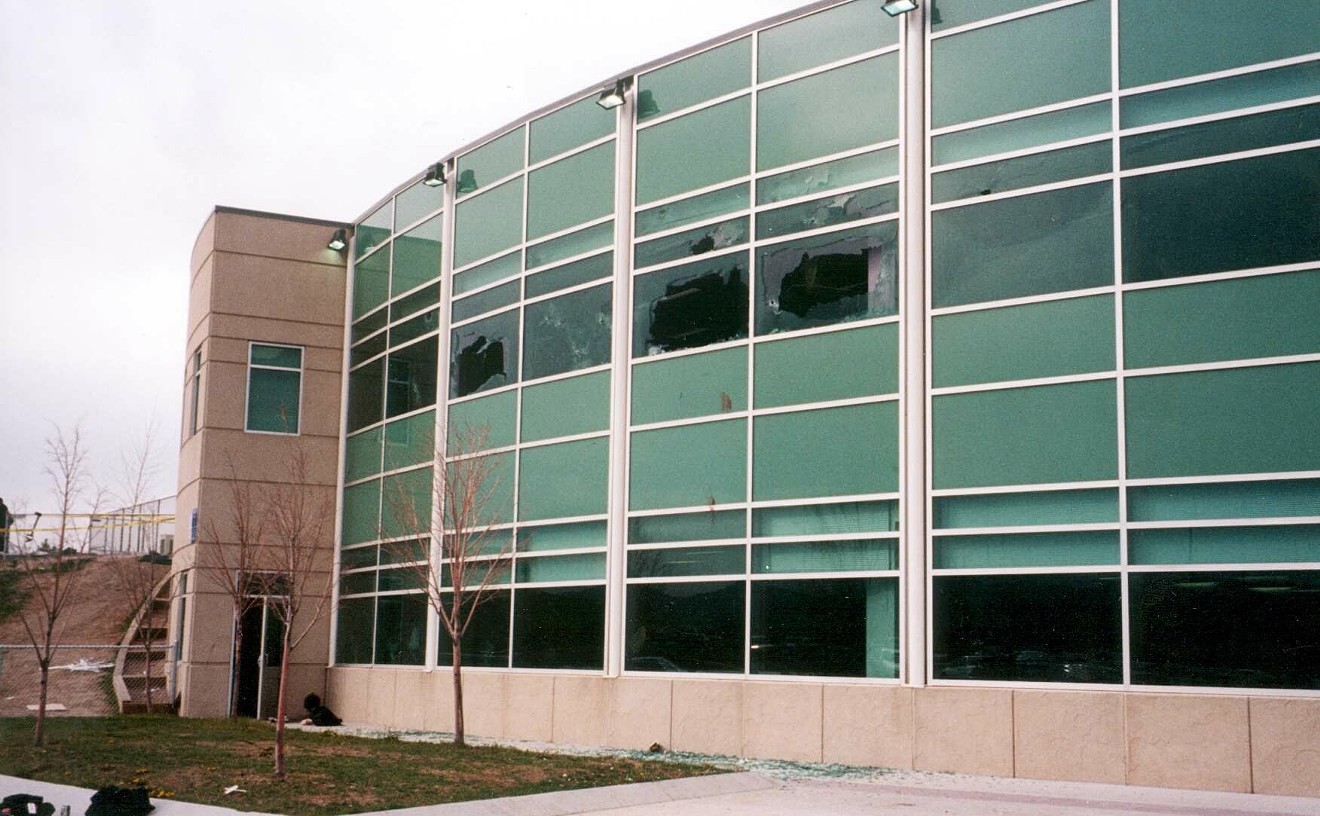Glass is infinitely recyclable, so it’s easy to imagine that the bottles and jars you put out at the curb every week are headed off to be melted down and remade — baby-food jar into baby-food jar, beer bottle into beer bottle, forever and ever, amen. But not in Denver, or in many other Colorado communities with single-stream recycling, where everything from paper to plastic to glass is thrown into the same bin. Instead of being endlessly recycled, the glass that Denver residents put in their purple bins is reused only once, as a liner for landfills.
Surprised? That’s understandable. The city doesn’t draw attention to the fact — and hasn’t since it became the first place in Colorado to switch to single-stream recycling in 2005, in an effort to get more residents to participate. “Single-stream itself is a very positive thing,” says Eric Heyboer of the Colorado Department of Public Health and Environment. “When you make it really convenient for people to recycle, they will recycle more.”
But convenience on one end creates more work on the other. The stuff that’s collected in the single-stream process must be sorted so that the paper, plastic and aluminum can go their separate ways. While the workers and machines at recycling facilities can separate the junk mail from the yogurt tubs and pop cans, they have a harder time picking out the glass.
That’s because it’s broken. Between your curb and the recycling center, glass is jostled, dumped and smashed numerous times. By the end of the sorting process, it looks like recycling confetti: broken glass mixed with shreds of paper, bottle caps and other tiny detritus.
At Colorado’s biggest recycling facility, which is located in Denver and owned by a private company called Waste Management, that confetti is transported to landfills, where it’s used in place of sand or gravel to line trash pits. The glass acts as a filter for the liquid that seeps out of the decomposing garbage, allowing the liquid to be collected and processed so that it doesn’t contaminate the groundwater. It’s known as a “beneficial reuse,” and the upside is that it saves natural resources from being used instead. The downside is that the glass is only reused once.
So how much glass is that? Waste Management won’t say how many cities or counties in Colorado it contracts with, but company officials report that its Denver facility ends up with 25,200 tons of beneficial-reuse glass each year. In 2014, more than 20 percent of that — or 5,500 tons — came from the city of Denver, where it’s estimated that glass makes up 16 percent of the recycling stream.Every piece of glass that is recycled in the city’s single-stream ends up as landfill liner
tweet this
In other words, every piece of glass that is recycled in the city’s single-stream ends up as landfill liner.
Those facts recently inspired two companies to try to improve the way that Denver — and the rest of Colorado — recycles its glass. Momentum Recycling, out of Utah, is building a facility that will use high-tech optical sorters to clean the shards of single-stream glass so they can be recycled into new glass instead of being used in landfills. Clear Intentions, based in Denver, has its own facility where it sorts glass that it collects separately from bars and restaurants through its Glass Valet program. That glass is also recycled into new glass.
“I cannot say how excited I am that these two companies have come to Colorado,” says Marjorie Griek, executive director of the Colorado Association for Recycling, a nonprofit organization that promotes recycling. “Glass has been a difficult issue for many years.”
Glass isn’t the only problem. Although Colorado is known for its green image, state recycling statistics tell a different story.
Colorado’s “diversion rate,” which is the amount of waste that’s diverted from landfills through recycling and composting, is just 23 percent, according to the CDPHE. The national rate is 34.5 percent, although experts agree that the way that Colorado calculates its rate differs from the way the federal Environmental Protection Agency figures the national rate.
A better comparison may be the numbers reported in a 2014 Columbia University study that surveyed all fifty states about how much waste they divert from their landfills. Colorado’s answer put the state in the bottom half of the nation.
“We’re pretty bad,” Griek says. “It’s really rather depressing.”
There are several reasons for this dismal showing, experts say. One is geography. Colorado has plenty of vacant land on which to build landfills, which means that those landfills charge lower “tipping fees” to waste haulers to dump their trash than landfills in states where open land is scarce. When it’s cheap to dump trash, municipalities and haulers have less financial incentive to offer recycling programs.
Colorado is also unusual, says the CDPHE’s Heyboer, “because we’re such a big state, with pockets of population centers, and in those population centers you have the Boulders, the Tellurides and the Aspens of the world that are super-gung-ho about recycling and have a green image. And then you have the rest of Colorado, which is a little different.”“We’re pretty bad. It’s really rather depressing.”
tweet this
For the rest of Colorado, recycling can be expensive. Most recycling facilities are located along the Front Range. It can be challenging for a far-flung trash hauler to collect enough empty pop cans to make it worthwhile to drive to Denver in order to take them to a recycling facility or sell them to an “end market” — the companies that take the used cans and turn them into new ones. “It eats into a lot of their profits,” Heyboer says.
In an attempt to boost Colorado’s recycling rate, state lawmakers created the Recycling Resources Economic Opportunity grant program in 2007. Heyboer is the administrator of the program, which is funded through tipping fees. Its primary purpose, he says, is to develop infrastructure that makes it easier to get recyclables to market. This year, RREO gave out eight grants totaling $1.8 million. One of the grants, for $202,000, was awarded to Momentum Recycling to help buy glass-processing equipment for its new plant. Clear Intentions received a $250,000 grant last year for a similar purpose.
“What attracted us to Clear Intentions is that they’re encouraging people to segregate glass from other recyclables,” Heyboer says. When glass is mixed in with everything else, it not only makes it difficult to recycle the glass itself, but the tiny broken pieces contaminate other recyclables like plastic and paper. “It kind of makes the end markets a little cranky,” Heyboer says. “They have to figure out how to separate the glass from the stuff they want.”
The challenges of recycling single-stream glass are on full display at the state’s biggest recycling facility, the Waste Management Franklin Street Materials Recovery Facility (MRF). Inside a dusty and noisy but surprisingly not too smelly Globeville warehouse in north Denver, a steady flow of crushed boxes, dented cans and crumpled paper speeds along the approximately five miles’ worth of conveyor belts that snake through the plant.
Along the way, humans and machines pick through the material. They remove non-recyclables — grocery bags, garden hoses — and separate the rest by type. An optical sorter scans some of it and uses air jets to blow plastic into a bin, while the rest continues down the line. A worker wearing a safety vest and hard hat flings milk jugs in one direction and paper in another. A reverse magnet repels aluminum cans, causing them to fly into a designated chute.
Much of the glass arrives already broken, and all of it ends up that way after bumping through the sorting equipment. Glass is also hard on the machinery, which causes additional problems for recycling facilities. “It’s like little knives running across the equipment,” Waste Management spokeswoman Melissa Kolwaite says.
At the very end of the line is a conveyor belt covered in beneficial-reuse glass. “This is what we’re faced with,” Kolwaite shouts over the whir of the machines. In addition to glass, the stuff rolling by includes beer-bottle stickers, the tops of cat-food cans, plastic forks, cassette tapes, the decapitated heads of coat hangers, cigarette butts and wrinkled coupons.
The MRF ends up with about 2,100 tons of beneficial-reuse glass each month, says plant manager Rich Conner. Nobody wants it, which is why the state has allowed Waste Management to use it as a replacement for gravel in the drainage layer of the trash “cells” at its landfills for more than five years. Before that, the company was using it in place of native soils as daily landfill cover — another example of a one-time reuse, Kolwaite says. “If it doesn’t have an end market, there’s nothing we can do with it.”
But that could change in early 2016, when Momentum plans to open its state-of-the-art glass-processing facility inside an old lumber warehouse in Broomfield just off U.S. Highway 287. The company estimates that it will cost between $7 million and $8 million to build.
Colorado is an ideal location, says Momentum’s Colorado business manager, Steve Derus, because it’s home to two bottle-manufacturing plants: the Owens-Illinois facility in Windsor and the Rocky Mountain Bottle Company in Wheat Ridge, which is owned in part by MillerCoors. Those plants have the ability to take used glass, melt it down and make new bottles.“I like to know that if I’m drinking a bottle of beer and I’m recycling it, it’s going to become another bottle of beer.”
tweet this
It actually takes less energy (read: money) to melt recycled glass than it does the virgin materials that glass is made of, which is why experts say the bottle companies would prefer to use it exclusively. The problem is that they can’t get enough. Because single-stream recycling is so popular, the majority of Colorado’s used glass is contaminated — and you can’t make a new bottle out of glass that’s polluted with paper shreds and bottle caps. Only clean glass can be recycled, and clean glass is hard to come by. CDPHE statistics back up that assertion: About 1.9 million tons of material was recycled in Colorado in 2013, the most recent year for which statistics are available. But only 25,191 tons — about 1 percent — was glass.
Momentum plans to buy the dirty glass from single-stream MRFs and clean it up. To do that, it will use screens and magnets to filter out contaminants, along with sophisticated, expensive optical sorters to separate the glass shards by color. The optical sorters are made in Europe, and Derus says Momentum will be the only company in Colorado to have them. At the end of the process, the contaminated glass shards will look like clean, shiny beads.
The plant will be capable of processing up to 5,000 tons of glass a month, and will sell between 75 and 85 percent of it to the bottle manufacturers to make into new bottles. “That’s true bottle-to-bottle recycling,” Derus points out, “and that’s endless.”
Any pieces that are too small to be used in that way will be sold to companies that use the “fines,” as they are called, in other ways, including adding them to road paint to make it reflective. The state grant will go toward buying equipment to process the super-tiny shards.
Once Momentum is up and running, the glass that’s generated in Colorado can be collected and recycled in Colorado. And thanks to the state’s hundreds of breweries, there’s a good chance the glass will be used in Colorado, too, Derus says. “I like to know that if I’m drinking a bottle of beer and I’m recycling it, it’s going to become another bottle of beer.”
Clear Intentions is aiming even higher when it comes to bottle-to-bottle recycling. The company’s goal is to turn 100 percent of the glass it collects into new glass, says president Brittany Evans.
Evans came to Colorado last summer from Utah. She started Clear Intentions while she was in college there; her dream was to create a “closed-loop” system that would take used products and make them into new ones without needing to mine any more virgin materials. Glass, she realized, was the best packaging material with which to do that.
“You can make a beer bottle for generations to come,” she says.
But because of the issues with glass in the single-stream, Evans decided that the best way to accomplish her goal was to collect it separately, sort it and then sell it to bottle manufacturers like the ones in Colorado. She and her team of fellow twenty-somethings applied for a state RREO grant, and when they received it last year, they decided to make the move here.
Clear Intentions is headquartered in a Denver warehouse not far from the Waste Management Franklin Street MRF. The warehouse is set up like a mini-MRF that processes only glass, most of it from Clear Intentions’ Glass Valet program. Bars and restaurants pay $30 a month to have Clear Intentions collect their glass once or twice a week. A few dozen establishments, many of them in lower downtown, have signed on so far.
“It’s super-easy on our end,” remarks Geoff Brent, general manager at Summit Music Hall. In addition to being environmentally sound, Brent says, the program saves room in the venue’s regular single-stream recycling bins. “There was no reason for us not to use it.”
“We’re recycling a lot of glass,” says Derek Langford, general manager at Howl at the Moon. “We fill up five 64-gallon containers every weekend. It helps us feel good that we’re not putting that glass into the landfill. Before we signed on with them, we were just putting all our trash in one container and dumping it into our bins. The only thing that got recycled was cardboard.”
Not that the idea of recycling glass by itself is new. Just ask Frank Rodrick, who owns #1 Recycling in Arvada. He’s been collecting glass from bars and restaurants in the metro area for free for 25 years and making money by selling it to Rocky Mountain Bottle Company. “No one else was really doing glass,” he says. “I became the glass king, so to speak.”“We fill up five 64-gallon containers every weekend. It helps us feel good we’re not putting that glass into the landfill.”
tweet this
Unlike the new companies, which have websites and marketing strategies, Rodrick operates quietly: He’s a family businessman who advertises in the phone book and got most of his nearly 300 customers through word of mouth. He says he currently collects up to 200 tons of glass per month, which is more than Clear Intentions does.
But the Clear Intentions crew has lofty goals. The company hopes to eventually expand the Glass Valet program to municipalities with recycling drop-off centers, individual neighborhoods and beer festivals. The idea is to process several thousand tons of glass per month.
Because Clear Intentions is still just a five-person operation, marketing director Todd Lehman and accounts and events manager Damon Michaels double as the company’s glass collectors. On Mondays and Fridays, they fire up an old orange truck that they bought on the cheap in California from a dry-cleaning company. They load it with empty maroon recycling bins stamped with the Clear Intentions logo and drive it through narrow graffitied alleys, swapping the empty bins for full ones and taking care to maneuver around line cooks on their smoke breaks.
Behind the Wynkoop Brewing Company, a cook in black chef pants and clogs approaches them as they drag the restaurant’s full bins to their truck. He tells them he’s happy the Wynkoop is recycling its glass separately.
“That’s what’s up,” he says.
More communities are beginning to recognize that glass in the single-stream is problematic, says Colorado Association for Recycling’s Griek. Summit County recently banned it for that reason, asking residents to take their glass to county recycling drop-off centers instead. Some cities, including Fort Collins and Loveland, allow glass in the single-stream bins but also provide separate glass-only containers at drop-off centers.
Denver doesn’t operate any glass drop-off centers, but a few private organizations do. Jobs for Thy Neighbor is a faith-based nonprofit that currently partners with four Denver churches, including Our Savior’s Lutheran Church in Capitol Hill, to place glass-only containers at their locations. Anyone can drop off their glass, and Jobs for Thy Neighbor contracts with #1 Recycling to pick it up to be recycled, says executive director Reverend Tina Yankee.
And despite the problems, Denver doesn’t have any plans to change. Rather, the city is banking on technology improvements, such as Momentum’s high-tech optical sorters, to ensure that Denver’s used glass gets recycled, says Charlotte Pitt, operations manager for Denver Recycles, the division of the city’s Department of Public Works that runs the recycling program.“There’s really been no downside from our end of the business.”
tweet this
Pitt believes that Denver’s single-stream recycling program has been a success. The city has been recycling since 1991, and when it switched to single-stream in 2005, participation skyrocketed, going from 40 percent of households to 75 percent, she says. In addition, the amount of material collected continues to rise every year. In 2014, Denver collected 34,350 tons of recyclables.
“There’s really been no downside from our end of the business,” Pitt says. “We collect more material and we have more people participating.” But, she adds, “we’re not blind to the fact that there’s a whole other industry once it leaves our hands.”











